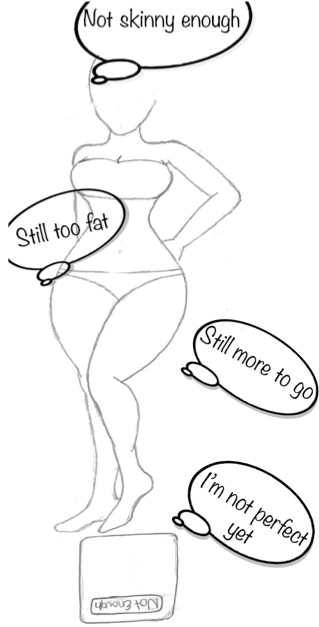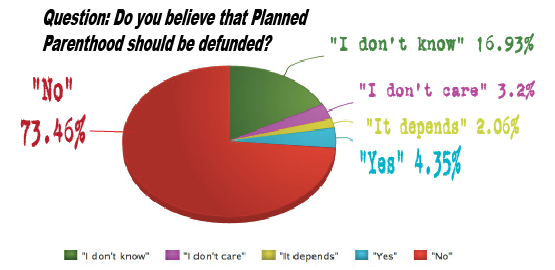By Caroline Thompson –
Imagine a genie walked through the door. If they gave you the ability to change anything about yourself or the ability to make yourself have the “ideal” or dream body, would you do it? Would you change your body into what you see everyday on television and in magazines? Would you change yourself to the way media wants you to look? To start off with, I asked a group of twenty people, ten guys and ten girls, to answer a short questionnaire. When I got each of the questionnaires back 90% of the girls and 50% of the guys had answered that they were uncomfortable with their bodies. Also, all of the girls had said that they are constantly trying to perfect their bodies to the those of models, actors, and television show characters. About 70% percent of the guys said that they are doing the same thing.
Throughout society, media has projected this “perfect” body for both males and females. The female image has been most commonly known to have an hourglass look, meaning bigger bust, small waist, and round hips. Males are portrayed to have a really toned body. In my opinion, portraying any kind of “perfect” or “ideal” beauty standard is wrong. This image is responsible for adolescents acquiring an eating disorder, to be self conscious all the time, and to self harm. Media portrays this “ideal” image through television shows, commercials, movies, magazines, etc. This allows kids to be exposed to the specific standards at very young ages.
According to LDS Living, an average American spends at least five hours a day watching television and another five hours on an electronic device looking at social media. With the amount of time that we spend watching all of these unrealistic beauty standards, it is no wonder that people are looking towards ways to “improve” their bodies.
“A recent study shows, 81% of girls age ten are afraid of being fat, and 35% of girls ages six through twelve have been on at least one diet.”
Unfortunately, some of this “awareness of weight” and appearance may be coming from the mothers. Based on a survey of adult women, it showed that more than half of them say they are disgusted with their bodies and 97% of women admit to at least one “I hate my body” moments each day, according to LDS Living. Some parents are pushing their children to have this “perfect” body. They make them to go on diets and they point out all the “imperfect” things about them. This is wrong on many levels. You as a parent shouldn’t be telling your child their body is imperfect, you shouldn’t be helping the media promote the beauty standard. Your child looks to you, they take what you say about them into account, so telling your child that he or she is fat is one of the reasons children go to extreme methods to “improve” or “perfect” their bodies.
“Over half of teenage girls and a third of teenage boys use unhealthy weight control behaviors such as skipping meals, fasting, smoking cigarettes, vomiting, and taking laxatives,” according to the ANAD website. One of the extreme measures a child take is an eating disorder. Teens nowadays are more afraid of weight gain than war or cancer.
The Youth Equipped to Succeed website states that studies prove that media has a negative effect on teens. Teens see this image all the time and think that’s what they have to look like. The thing they don’t realize is this image is unrealistic. The “perfect” image that you see is always air brushed and is digitally altered so that the person appears to be 23% skinnier than the average person.
Other than eating disorders, teenagers also tend to lean towards self harm. This is mostly caused when peers start bringing down self esteem. A 2011 study from the Center for Adolescent Health at the Murdoch Children’s Research Institute concluded that around one in twelve kids self-harm, states the Huffpost Healthy Living. Self harm is mostly caused when kids are feeling like they have nowhere else to go, when peers are bullying them for being “fat” or “overweight.” With this idea that everyone who isn’t stick thin is overweight going around, more teens have been known to self harm. Media, in a way, is promoting self harm. When teens see this ideal image of a perfect body, they start to harass the kids who don’t fit that image. This harassment causes teens to be insecure, it causes them to go to severe measures to stop it, such as self harm or eating disorders.
This “perfect” image, this idea of the “perfect” person has to stop.
I’m not saying that we have to prevent kids from being able to use social media. But, what can we do then?
Well one thing we can do is stop helping promote this “ideal” image. We can stop telling our children they are overweight, and we can stop peers from teasing or making fun of people. I know we can’t make social media get rid of their ridiculous image, but we can help our peers around us understand that this image of theirs is unrealistic and definitely not perfect. We as a community of teenagers need to promote amongst ourselves a body positive vibe and awareness. The body that you have today is the body you were created with, don’t destroy it, don’t harm it. You are all still at an age where your body is gonna change, embrace it and screw everyone or everything that tells you otherwise.



















